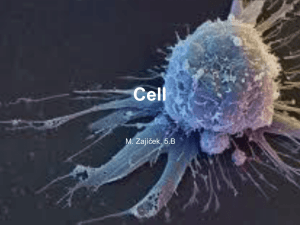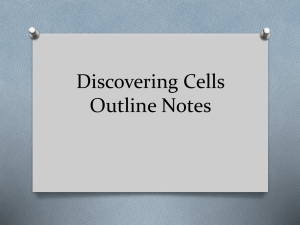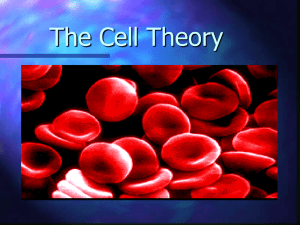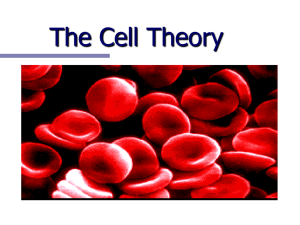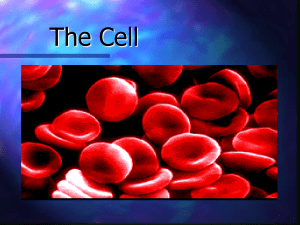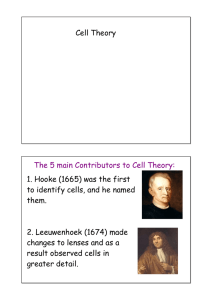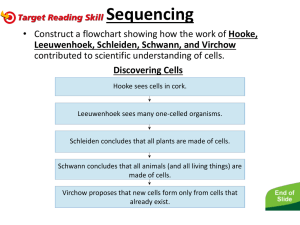Some random cell facts The average human being is composed of
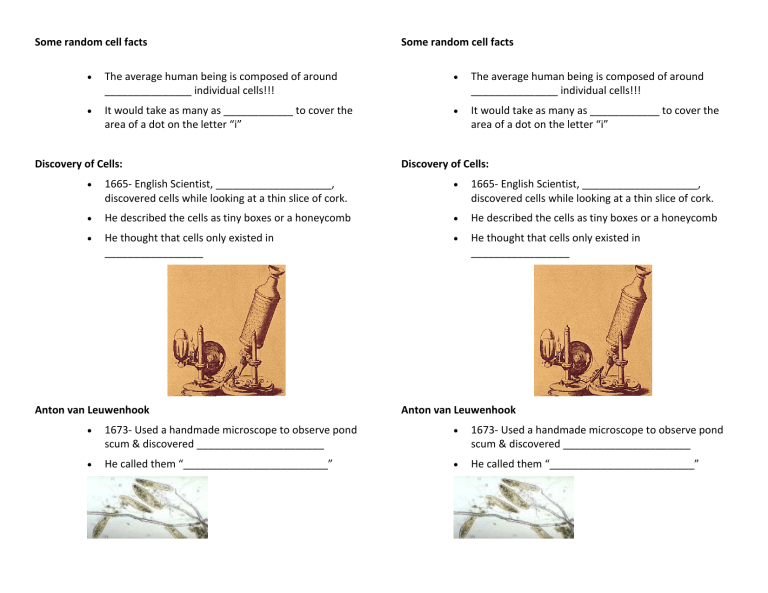
Some random cell facts
The average human being is composed of around
_______________ individual cells!!!
It would take as many as ____________ to cover the area of a dot on the letter “i”
Discovery of Cells:
1665- English Scientist, ____________________, discovered cells while looking at a thin slice of cork.
He described the cells as tiny boxes or a honeycomb
He thought that cells only existed in
_________________
Some random cell facts
The average human being is composed of around
_______________ individual cells!!!
It would take as many as ____________ to cover the area of a dot on the letter “i”
Discovery of Cells:
1665- English Scientist, ____________________, discovered cells while looking at a thin slice of cork.
He described the cells as tiny boxes or a honeycomb
He thought that cells only existed in
_________________
Anton van Leuwenhook
1673- Used a handmade microscope to observe pond scum & discovered ______________________
He called them “_________________________”
Anton van Leuwenhook
1673- Used a handmade microscope to observe pond scum & discovered ______________________
He called them “_________________________”
He also observed __________________ from fish, birds, frogs, dogs, and humans
Therefore, it was known that cells are found in
____________________________
150-200 year gap?
Between the Hooke/Leuwenhoek discoveries and the mid 19 th century, very little cell advancements were made.
This is probably due to the widely accepted, traditional belief in __________________________________
Examples:
1.
2.
19th Century Advancement
Much doubt existed around Spontaneous Generation
Conclusively disproved by_________________
He also observed __________________ from fish, birds, frogs, dogs, and humans
Therefore, it was known that cells are found in
____________________________
150-200 year gap?
Between the Hooke/Leuwenhoek discoveries and the mid 19 th century, very little cell advancements were made.
This is probably due to the widely accepted, traditional belief in __________________________________
Examples:
1.
2.
19th Century Advancement
Much doubt existed around Spontaneous Generation
Conclusively disproved by_________________
Pasteur: “Ummm. I don’t think so!”
Development of Cell Theory
1838- German Botanist, Matthias Schleiden, concluded that all _________ are made of cells
Pasteur: “Ummm. I don’t think so!”
Development of Cell Theory
1838- German Botanist, Matthias Schleiden, concluded that all _________ are made of cells
1839- German physiologist, Theodor Schwann, who was a close friend of Schleiden, stated that all
_______________________ are composed of cells.
1839- German physiologist, Theodor Schwann, who was a close friend of Schleiden, stated that all
_______________________ are composed of cells.
1858- Rudolf Virchow, German physician, after extensive study of cellular pathology, concluded that cells must
___________________________________.
The Cell Theory Complete
The 3 Basic Components of the Cell Theory were now complete:
______________________________________
(Schleiden & Schwann)(1838-39)
1. ___________________________________________
___________________
2.
_____________________________________________
_________________
______________________________________ (Schlei den & Schwann)(1838-39)
3.___________________________________________
___________________
_____________________________________________
_______ (Virchow)(1858)
Modern Cell Theory
Modern Cell Theory contains 4 statements, in addition to the original Cell Theory:
1858- Rudolf Virchow, German physician, after extensive study of cellular pathology, concluded that cells must
___________________________________.
The Cell Theory Complete
The 3 Basic Components of the Cell Theory were now complete:
______________________________________
(Schleiden & Schwann)(1838-39)
1. ___________________________________________
___________________
2.
_____________________________________________
_________________
______________________________________ (Schlei den & Schwann)(1838-39)
3.___________________________________________
___________________
_____________________________________________
_______ (Virchow)(1858)
Modern Cell Theory
Modern Cell Theory contains 4 statements, in addition to the original Cell Theory:
__________________________________________ which is passed on from cell to cell during cell division.
All cells are basically the same in
______________________________________
___________________________
All basic chemical & physiological functions are carried out _________________ ________ (movement, digestion,etc)
Cell activity depends on the activities of sub-cellular structures within the cell
(_____________________________________)
__________________________________________ which is passed on from cell to cell during cell division.
All cells are basically the same in
______________________________________
___________________________
All basic chemical & physiological functions are carried out _________________ ________ (movement, digestion,etc)
Cell activity depends on the activities of sub-cellular structures within the cell
(_____________________________________)
How has the cell theory been used?
The basic discovered truths about cells, listed in the
Cell Theory, are the basis for things such as:
Disease/Health/Medical Research and
Cures(AIDS, Cancer, Vaccines, Cloning, Stem
Cell Research, etc.)
Some parting thoughts
It is amazing to think that the cells that make up our bodies are just as alive as we are. Humans are just an intricately designed community of cells, which must work together to survive source: worldofteaching.com
How has the cell theory been used?
The basic discovered truths about cells, listed in the
Cell Theory, are the basis for things such as:
Disease/Health/Medical Research and
Cures(AIDS, Cancer, Vaccines, Cloning, Stem
Cell Research, etc.)
Some parting thoughts
It is amazing to think that the cells that make up our bodies are just as alive as we are. Humans are just an intricately designed community of cells, which must work together to survive source: worldofteaching.com
